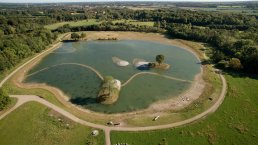The recently constructed lake, Glisholm Sø, collects rainwater in the growing southern part of Odense and offers a recreation area rich with plant and animal life.
Historically, when rain poured over Odense Municipality, the nearby stream, Lindved Å, would be flooded by the huge volumes of water and reach residential areas south of the city. The municipality has put an end to this with the construction of Glisholm Lake, designed to collect and store rainwater. Today, Glisholm is Odense’s largest lake with a wet volume of approx. 42,000 m3 and a surface area of 70,600 m2.
34
LITERS PER SECOND IS GENTLY RELEASED FROM GLISHOLM SØ TO NEARBY STREAM, LINDVED Å
In the event of heavy rain and cloudbursts, which are expected to become more frequent in the future, the lake can hold up to 87,000 m3. In addition, the lake is equipped with a sand trap to remove any sand, gravel and oil residues that might accumulate in rainwater and runoff, keeping the lake clean and protecting ecosystems.

Glisholm Lake receives rainwater from an area of 677,000 m2 soon to house new industrial developments and residential areas.
But Glisholm Lake is more than just a tool in Odense’s struggle against future wild weather. In cooperation with the Danish Society for Nature Conservation, Odense Municipality has established wetlands, paddocks and small islands with trees, rocks and poles – a thriving place for birds such as herons and cormorants. Citizens can also enjoy the rich animal and plant life from landscaped paths and benches adorning the lake’s surrounds. Odense refers to Glisholm Lake as a “three-in-one of climate adaptation, nature conservation and recreational value”.
How the Global Goals are addressed
Sustainable Cities and Communities
With a growing residential and industrial area south of Odense, the need for handling urban rainwater rises. Glisholm Lake is able to keep up with this development and protect the new areas.
Life on Land
The lake and surrounding area of 127,000 m2 contain wetlands, small islands, trees and rocks, and are home to a number of terrestrial animals, including shorebirds and salamanders.
Partnerships for the Goals
Glisholm Lake was developed in collaboration with VandCenter Syd and the Danish Society for Nature Conservation, to create a technical solution that simultaneous- ly promotes biodiversity.



